THE MYSTERY OF TATÁRLAKA
Klára Friedrich
Part 1
Twenty three years ago, one of my colleagues, who knew about my deep interest in the Székely Magyar Runic Script and the Sumerian-Hungarian connection, with obvious pleasure gave me a publication, in which for the first time I saw the disk and the two inscribed tablets from Tatárlaka. Since that time, I have been collecting the various opinions and decipherments of the inscriptions on these objects. This comprehensive overview is the result of this collection and, at the end, I offer my own opinion.
We can write with greater credibility about the object of our research if we can examine the original in detail, even handle it. In the case of the runic stone of Margaret Island and the shaman stones of Ferenc Csepregi, which were declared unseen to be forgeries, upon actual examination, I was convinced of their antiquity, originality and importance. It seems as if the spirit of the long-gone master of runic- writing is still waiting in the tablets for someone to understand the message they contain.
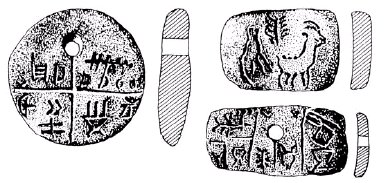
[We were unable to obtain a high quality picture file and, therefore, supplement the author's illustration with one from our files (below). Ed.]
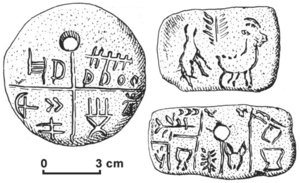
For a long time, Gabor and I had been anxious to actually examine the Tatárlaka disk which, according to the books written by László Götz and Lizett Kabay, was at the Transylvanian Historical Museum in the city of Kolozsvár (Cluj). In December, 2003, in Kolozsvár, Gábor was informed by the employees of the museum, who only spoke Rumanian, that the disk and the tablets were being examined in Germany. When we returned home, Gábor wrote the following letter in Rumanian to the curator of the museum:
Catre: Dl.Piso Ioan
directorului al Muzeul National de Istorie din Ardeal
str.Constantin Daicoviciu Nr.2 400020 Cluj-Napoca
Stimate Director!
Ca presedintele al Asociatiei de Scriere Runica si Crestatura Maghiara as – avea rugamintea catre dvs.
În anul 1961renumitul arheolog Nicolae Vlassa în apropierea Tartariei (Tatárlaka) a descoperit obiecte cu importata de istorie al scrisului,din care pe una stiinta istoriei,de atunci o numeste amuletul din Tartaria (Tatálakai amulett). Obiectele gasite atunci au fost duse în muzeul condus de dvs.
În 2003 decembrie cînd am fost în Cluj as-fi vrut sa-le vad în original,dar cînd m-am interesat ca unde le pot vedea am primit raspunsul ca în prezent se aflu în Germania pentru cercetare.
În viitorul apropiat mai multe membrii al asociatiei noastre vrea sa viziteze muzeul dvs. pentru a vedea obiectele cu scriere runica gasite în apropierea Tartariei,as vrea sa ma informati despre urmatoarele:
-
Din ce scop,unde si de cînd se aflu discurile ceramice în cercetare? (Informatiile de mai sus sunt necesare pentru scrierea unei carti despre discurile ceramice cu scris runica gasite în Tartaria.)
-
Cînd sunt duse înapoi obiectele în muzeul dvs.?
Va mai cerem ajutorul sa ne informati despre descoperirile a d-nei arheolog Torma Zsofia,daca se aflu cîteva dintre ele în muzeul condus de dvs.?
Ajutorul si colaborarea va multumesc anticipat si va rog ca raspunsul dvs. sa fie trimis pe adresa asociatiei:
sau pe adresa e-mail: Ez az e-mail-cím a szpemrobotok elleni védelem alatt áll. Megtekintéséhez engedélyeznie kell a JavaScript használatát.
Dear Piso Joan, Director of the Museum of History:
As President of the National Society of Hungarian Runes and Runic Writers, I am turning to you with a request.
In 1961, the well known Rumanian archeologist, N. Vlassza, while excavating in the Transylvanian region of Rumania, near the village of Tatárlaka (Tartaria) found significant artifacts pertaining to the history of writing, one of which historiography calls the Tatárlaka amulet. These finds ended up in the Historical Museum of Transylvania, which is under your directorship. I was in Cluj in December, 2003, and would have loved to see the original artifacts. When I was inquiring about these artifacts, the employees replied that they were not there but were being studied in Germany. Since, in the near future, several members of the National Society of Hungarian Runes and Runic Writers would like to see the objects from Tatárlaka, I am turning to you with the following sincere request for information:
-
Where, since when and for what reason are the disks being examined? (We would like to know this because we are writing a book about the objects, the results of their examination and the places where they have been exhibited.)
-
When can we expect the artifacts to be returned to your museum?
If it is at all possible, please let us know if there are any artifacts in your museum from the excavations of the archeologist, Zsófia Torma.
We thank you in advance for your cooperation and your help. Please send your reply to the following address:
e-mail: Ez az e-mail-cím a szpemrobotok elleni védelem alatt áll. Megtekintéséhez engedélyeznie kell a JavaScript használatát.
***
We have not yet received an answer. In July, 2004, Gábor and I again went to the museum where seven months ago we had received information about the tablets. The employees, who spoke only Rumanian and who, by the way were very courteous, told us again that the tablets were still being studied in Germany. We were told that, instead of examining the original objects, we could see exact replicas displayed in the display cases and we were offered copies which we could purchase. The disk cost 25,000 lei and the tablets cost 20,000 lei each, which is a total of 500 Hungarian forints.
At the museum, the information accompanying the exhibits is in the Rumanian language only. The artifacts in the Neolithic section come from the excavations of Zsófia Torma (1840-1899), yet her name is not mentioned anywhere. We were happy to discover, in one of the display cases, her finds from the crumbling bank of the River Maros. They were broken clay pitchers with runic script on the bottom, among them 6,500 year-old interesting runic letters, e.g (H. Zs.)
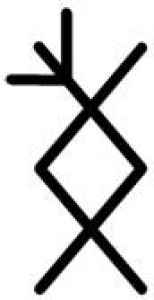
So, let us take a look at what is contained in these finds, which attracted the interest of the world's most famous archeologists and Sumerologists.
In 1961, Nicolae Vlassza, an archeologist from Kolozsvár (Cluj), opened up an ash-filled grave in Tatárlaka in Transylvania, in which he found the broken and burned bones of a man, approximately 40 years old. Beside him, there were 26 clay figures, two stone figures, one bracelet made out of seashells, one fired-clay disk and two rectangular clay tablets. According to carbon-dating of the bones, the find is 6-6500 years old.
Runic script and pictographs are found on the disk, pictographs only on one of the tablets. Both of these have a hole in the upper one third. On the other tablet there is the image of two animals that look like goats and a plant. The signs on the disk and pictographs on the tablets are 1000-1500 years older than the pictographs on the first Sumerian finds. The Tatárlaka finds are made out of local clay. Let us see what conclusion the researchers reached from these dry facts.
According to Nicolae Vlassza, the archeologist who excavated the grave, the inscriptions on the Tatárlaka tablets are not unique but are closely related to the signs on the pottery of Tordos and of the Vinca culture near Belgrade. He thinks it possible that between 4000 and 3000 B.C., groups of Sumerians from Mesopotamia settled in the northern part of the Balkans and in Transylvania and the runic script of Tatárlaka was developed under their influence.
In line with Vlassza’s opinion, the publication mentioned in the introduction of this study, the Forrás, published in Kecskemét, in its November 1981 issue, allowed the publication of articles about our true ancient history by writers such as Ferenc Kunszabó, György Vértessy and K. Endre Grandpierre.
On page 59, is the beginning of the study by Boris Perlov entitled: "The Message of Tatárlaka". From this article we learn that, in 1961, the scientific world was surprised by the sensational archeological news that, in a small Rumanian (!!!) settlement of Tatárlaka in Transylvania, runic script had been excavated, which was a thousand years older than the oldest Sumerian writing. Perlov lists the opinion of the following scientists:
-
Falkenstein, a German Sumerologist, who states that the writing found in Tatárlaka was developed under Sumerian influence.
-
M.S. Hood, an English archeologist, who states that the disk and tablets were carried by Sumerian merchants to Tatárlaka, where the native inhabitants did not understand the written signs but copied them and used them for religious purposes.
-
Perlov does not name the Soviet Academy of Sciences Archeological Institute's Sumerologist, only gave his opinion: In the grave at Tatárlaka a man’s bones were found. The tablets were locally made, part of a widespread writing-system and can be connected to Mesopotamia and the Hungarian Kőrös Culture. In my opinion, this is very nice, however, the writing on the disk is blood-curdling. Word for word it says: "In the fortieth year of the reign of the God Saue, we ritually burned the clan-chief in his mouth. He is the tenth".
According to the unnamed expert, the people of Tatárlaka roasted their retired clan-chiefs and ate them. They must have enjoyed this because they were devouring the tenth. Perlov doesn't agree with this interpretation implying cannibalism. On the contrary, following a clockwise direction, he offers the following decipherment, using the Sumerian signs of the Jamdet-Nasr culture: "The four(th) governor God Saue, in honor of the wise head of the nation, burned one." The signs of Jamdet Nasr, which were used to help in the decipherment, also indicated that there were priestesses, therefore Perlov does not deny the presence of women among the religious leaders. He poses an important question: "Who then were the ancient inhabitants of Tatárlaka who, in the 5th millennium before Christ, wrote in Sumerian before Sumer even existed?" Can we even expect that our name (Hungarian) would be mentioned? After Perlov comes another Soviet Sumerologist’s decipherment, who writes about the "ancient Slavs" whom the Celts worshipped as gods.
In his book: "Keleten kél a Nap" (The Sun Rises in the East) (Püski, 1994), the very knowledgeable László Götz writes that the theories of Perlov and Kifisin are "the Sumerologist’s fairy-tales of ancient history and nauseating effusiveness of Slavic chauvinism" which fabricate the theory that the ancient Slavs invented writing and that they were the ancient populace of Transylvania. László Götz connects the Tatárlaka tablets with the groups of Mesopotamian-Sumerian metallurgists and metal-workers, who arrived in large numbers by sea, protected by bodyguards and who spent a long time in Transylvania.
Nándor Kalicz, in his book entitled "Agyagistenek" (Clay Gods) (Corvina Publishing, 1970) writes an overview of Hungary's Neolithic and Bronze Age artifacts. I quote: "In Alsótatárlaka (Tartaria) in Transylvania, in a cultic pit, beside 26 idols were found one fired clay tablet and two fired clay disks. The signs on these are almost identical to those found in Mesopotamia".
Part 2
László Gyula, Professor of Archeology, in his book, "Vértesszőlőstől Pusztaszerig" ("From Vértesszőlős to Pusztaszer") (Gondolat Kiadó Budapest. 1974) following the opinion of Nándor Kalicz mentions these finds and adds: "...we were on the right path when we discussed the Neolithic Era and started with the observation that, from the area from where the ice was retreating, not only plant and animal life moved up from the South to reestablish themselves, but they were accompanied by humans who lived on them."
Kornél Bakay, in his work entitled: "Őstörténetünk régészeti forrásai" (Archeological Sources of our Ancient History) (Miskolci Bölcsész Egyesület, 1997) gives an overview of the time-frame of cultural history of Europe and Asia from 10,000 B.C. to the beginning of our era. He dates the finds of Tordos and Tatárlaka to 8-6000 B.C. At that same time, ceramics appear in Jericho, houses made out of dried mud-bricks in Anatolia, the first agricultural villages in China and in Southern Europe, and pigs, sheep, and goats are domesticated in Mesopotamia.
In 1975, in Buenos Aires, Anna Walter Fehér, published the total of her enormous research, under the title of: "Az ékírástól a rovásírásig" ("From Cuneiform to Runic Writing"). It is to the greatest disgrace of the Hungarian Publishing Industry that, in the last 29 years, this work has not been published in Hungary. Even if I risk being stoned for it, I have to say that this book should be among the books carried by our national bookstores rather than the Arvisura, the Young Shaman of the Mansi. Anna Walter Feher believes that, based on the research of Zsófia Torma, the knowledge of writing originated in the Carpathian Basin and was carried to Mesopotamia. She shows pieces related to the tablets of Tatárlaka: Székely-Magyar Runic Script from the collection of Zsófia Torma, the disks from Tordos and the Olt Valley, runic signs from Karanovo and Gradesnica as well as the disk of Phaistos, which was decoded by Lizette Kabay, folklorist, as a Hymn to the Sun.
Mrs. Fehér published from her own meager resources Zsófia Torma’s Ethographische Analogien, which had been readable only in German up to this point, and entitled it Sumér Nyomok Erdélyben, (Traces of Sumer in Translyvania). This is currently available only in a very poor quality photocopy. This was augmented by Gábor Jáki with the carefully and lovingly-written biography of the lady archeologist. Moreover, he added a chapter with the title: "What has Transpired Since then," in which we can read a splendid description of the tablets of Tatárlaka. We learn from him that, according to Professor János Harmatta, the two tablets with the runic script contain a list of votive gifts to the four Sumerian gods: Enlil, Palil, Usmu and Samas. It is interesting to note that, beside dishes, horses and barley, the list also contains spelt wheat. After the discovery at Tatárlaka, Anna Walter Fehér sent a letter to Vlassza, bringing to his attention Zsófia Torma’s unpublished collection of signs. The Torma manuscript was in the hands of Vlassza at this point, who replied that the manuscript was in very poor condition, falling apart, the pencil-drawn illustrations were fading and the University of Kolozsvár (Cluj) was intending to publish the whole work.
Since then, unfortunately, both Anna Walter Fehér and Vlassza have passed away and who knows under what unmerited conditions this most important proof of our early culture further deteriorates. This was the life-work of the self-sacrificing scholar, even genius, Zsofia Torma. It was with great pleasure that, while I was working on this manuscript, I was able to buy at the Fehérlófia book store the book Sumér nyomok Erdélyben (Sumerian Traces in Transylvania), well edited and easy to read (Published by Magyar Őskutatás, Buenos Aires, 1972)
The cover of the book by Sándor Forrai: Az ősi magyar rovásírás az ókortól napjainkig (The Ancient Hungarian Runic Writing from the Ancient Era to Today) is decorated with our disk (Antologia Kiadó, 1994). The professor states that three signs correspond to the Z, NY and GY of the Székely Magyar Runic Script. He considers them to be ligatures of the pictographs (ND) and (BP).

He mentions the Mesopotamian, Egyptian, Cretan and Phoenician parallels. His standing as a serious scientist and researcher is made more credible by the fact that he doesn't make dogmatic statements but emphasizes the necessity of further research and, in connection with the find of Tatárlaka, he recognizes the work of Zsófia Torma and laments the disregard for her work. We learn from Sándor Forrai that János Harmatta also reminds us that Zsófia Torma, already in 1879, brought the relationship between the Torda and the Mesopotamian Runic Script to the attention of the world.
János Makkai, Professor of Ancient History, wrote an excellent comprehensive summary, more than two hundred pages long, entitled A tartariai leletek (The Finds of Tatárlaka Akadémiai Kiadó, 1990) In this work, we can finally read a factual and professional description instead of the second or third hand information we have had up to now. He met Vlassza several times and visited the site of the excavation. He illustrated his account with the help of cross sections and collections of signs. The book is dedicated to Vlassza, who died young, before the age of 50. Unfortunately, he does not include Vlassza’s actual descriptions of the excavation site and the exact list of artifacts found there.
Finally, from János Makkay we learn about a collection of artifacts that Vlassza called magical/ritual, religious complex materials: a grave containing the bones of a 30-40 year-old person -- sex unknown! -- beside the broken and scorched bones, 26 clay and 2 alabaster figurines, a bracelet made out of spondylus shells and three tablets. Six years later, in 1967, Vlassza stated that the objects were in the broken pieces of a pipe-footed vessel and part of the top of a larger vase was also found.
During her archeological excavations in Tordos, Zsófia Torma also found clay urns filled with ashes, some containing human bones. Professor Makkai knows nothing about the anatomical examination of the scorched bones. He mentions several possibilities about the person who made the clay tablets. He considers it most probable that somewhere around the Aegean Sea region, a Sumerian, possibly a scribe, taught a native of Transylvania, or a merchant, the runic writing which was taken to Transylvania in person, otherwise the tablets could not have been made from local clay. He also mentions other possibilities. He definitely distances himself from the proponents of the Sumerian-Hungarian relationship and, in this matter, he is unfortunately a follower of Géza Komoróczy.
Our book publishers did us a disservice in that this book is almost impossible to access. Finally, I was able to read a copy, which was kindly loaned to me by Csaba Varga, for which I thank him.
Tibor Baráth, former Professor of the University of Kolozsvár, later emigrant historian, represents on the cover of his book: A magyar népek őstörténete (The Ancient History of the Hungarian People, published by Zoltán Somogyi, USA, 1997) an accurate depiction of the disk. Inside, the three tablets are also accurately depicted.
A similarly faithful reproduction can be found in the first part of the book by Gábor Bartha: Erdély (Transylvania, Progresszio Gt. 1989) and also in the magazine, Forrás. I note here, that those decipherments based on inexact drawings of the tablets have no credibility.
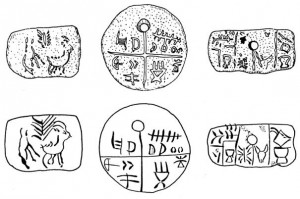
Inccurate drawings
Most often, the small V sign on the left horizontal line of the disk, which is divided into four by a cross, is omitted from the upper left quadrant, yet this is an important sign. It is heartening that more and more people wear a copy of the Tatárlaka disk around their neck, although, because of the manufacturers’ irresponsibility and carelessness, these are not accurately made and the secret message of our ancestors of 8-9000 years ago is erroneously communicated and, if we attribute to it some magical protection, it does not accomplish its goal.
According to Tibor Baráth, in 2000 B.C., similar disks were manufactured and used in Crete and he includes drawings of these.
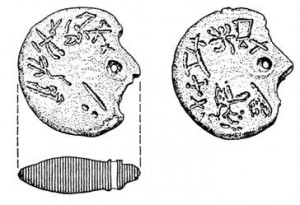
Two disks from Knossos
(from Baráth Tibor: A magyar népek őstörténete)
Tibor Baráth dates the finds to the Bronze Age (2000-500 B.C.). His opinion is that a "sun-waiter, a person who awaits the sun" or "star observer" might have stood at the place of the finds and the disks may have been used by an astronomer to help to prepare a calendar. The holes on the two disks were not used to hang the disks but rather to observe the appearance of the first rays of the sun. He proves this with the observation that, on the rectangular tablet, there are rays drawn radiating from the hole used to observe the sun. He thinks that the Cretan disks served a similar purpose. He states that the runic signs on the Tatárlaka disks correspond to the Scythian-Hun-Magyar runic script. The meaning of the runic text is as follows: "In this direction God comes at 4:00 o’clock, in the sign of Cancer after ten periods." So the astronomer was observing during the period between June 11 and June 20, when the sun rises on the Tatárlaka meridian a few minutes after four in the morning.
The decipherment of the second tablet with a hole.
"The Sun (the Lord of the Sky) shines through the hole of the sun rays in the constellation of Cancer." So this tablet is also used to observe the summer Solstice.
There is no hole in the third tablet, the Sun, because the tablet signifies the Winter Solstice. It is an important observation that the "Sunwaiter" of Tatárlaka is being compared to the great Western European megalithic observatories and brings to our attention the monolith on Somló Mountain above Csíksomlyó. The pictographs on the top of this block of stone can be connected to the signs of the Zodiac. This calendar stone was removed by the Franciscans because they considered it a relic of pagan origin, used for sacrifices. It was removed from its original place but was not destroyed because the Székelys demanded that their ancestral monument be preserved.
Finally, a beautiful patriotic sentence from Tibor Barath’s book is appropriate here: "... on the the disk of Tatárlaka, which caused a world sensation, appear not senseless scratches, as Professor Hood theorized, but a perfect Hungarian text."
László Ruzsinszky accepts Tibor Barath’s interpretation and opinion about the disk and mentions it in his book: A ragozó ősnyelv írásának világtörténete (The World History of the Written Ancient Agglutinative Language) (Komló 2000).
Egyptologist, László Kákosy in his great comprehensive book: Ré fiai (The Sons of Re) (Gondolat 1979) also mentions Tatárlaka:
"It is characteristic of the connection between the two cultures that writing appeared in Mesopotamia and Egypt at almost the same time, in the former, somewhat earlier. The oldest relics of the Mesopotamian pictographic writing are known from Iran (Tepe Jahia), indeed from Transylvania too (Tartaria)... The outside influence explains the fact that, while in Mesopotamia, in the Uruk Culture, the stage preceding the writing of sounds, pictographic writing, can be shown, in Egypt we suddenly see an already complicated writing system."

